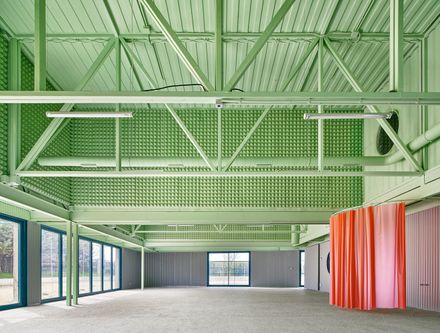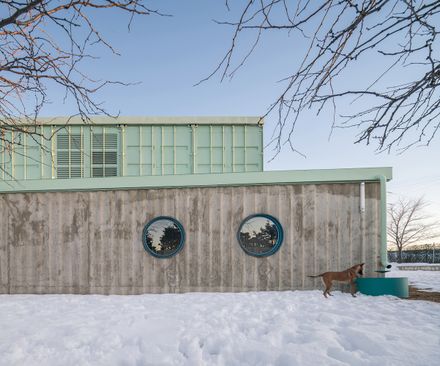Educan School For Dogs, Humans And Other Species
CONSTRUCTION
Servicios Integrales Alji
STRUCTURAL ENGINEERING
Mecanismo
LEAD ARCHITECTS
Enrique Espinosa, Lys Villalba
TECHNICAL ARCHITECT
Javier Reñones Marín
STEEL CONSTRUCTIONS
Miguel Torrejón
FACILITIES ENGINEERING
Alberto Espinosa
TECHNICAL CONSULTANT
Jorge López Hidalgo
COLLABORATORS
Maria Paola Marciano, Irene Domínguez
YEAR
2020
AREA
3229 ft²
CATEGORY
Animal Shelter
LOCATION
Brunete, Spain
Text description provided by the architects
01. Multi-species architecture. Eva, Carlos, two Belgian Malinois – Bicho and Bomba –, Harris the owl, five swift families, six kestrel families, and twenty sparrows, are all companion species.
They live and learn together in this building, thirty kilometers west of Madrid. Sitting in amongst fields, in a rural environment transformed over recent decades by urban development and intensive pesticide-reliant agriculture, Educan School is trialing ways to recover the conditions of the ecosystem.
Its architecture is a multi-species design
While the two main classrooms are busy with dog-human pairs practicing agility or dog sports like Schutzhund, birds’ nest on the upper floor’s nest-facade, boasting ideal views and orientation.
Small birds of prey feed on rodents, maintaining a balance with crops and other local flora. Small birds and bats – who also inhabit the lettering on the south facade – feed on insects, including mosquitoes that can carry certain canine diseases, and are part of the pollination cycles of flowers and plants in the surrounding fields.
Sparrows made an impromptu appearance in this self-regulating ecosystem, nesting in the circular holes of the container edges.
Non-humans are at the center of the design. The floors, usually designed for people and their shoes, are adapted to the pads and joints of canine paws: the training classrooms use removable rolls of PTE-based synthetic turf, approved for canine training, while theory classrooms are finished in semi-polished, exposed aggregate concrete made of river pebbles.
The average eye height drops from over a meter and a half to just half a meter. Interior openings are raised to heights of more than one meter to avoid doggy distractions; louvered window shutters shade the south facade, leaving enough space below for dog traffic to the outside, where rainwater from the roof is harvested in large troughs for dogs and birds.
A spoken word turns to bark, and the interior surfaces are clad with sound-absorbing pyramid foam insulation, minimizing echo, noises, and reverberation.
MATERIAL CROSSOVERS AND CONSTRUCTIVE INNOVATION
The building uses a diverse range of materials, combining different building techniques, trades and production systems: from material ecology and waste reduction with the reuse of shipping containers, to the adaptability and thermal mass provided by in-situ concrete and its smooth and undulating formwork using sheets recovered from the off-cuts for the new trusses; from the standardisation and optimisation of industrial metal sheet panels to the precision of laminated timber CNC-cut joints; from the industrial standardisation of basic ingredients like 40' HC containers to the hand-crafted ironwork offering customised joints, bespoke assemblies and unique elements such as bench legs, lamps or large sliding doors helping open and close the different spaces; from automated air conditioning systems to manual bioclimatic control elements like the perforated shutters or roller blinds; from the material weight of the foundations and concrete walls to the lightness of the rest of the dry-assembled elements.
Educan is also an experiment that demonstrates that agricultural architectures, usually considered lesser within the discipline itself, can also be places of exploration and architectural innovation.


































